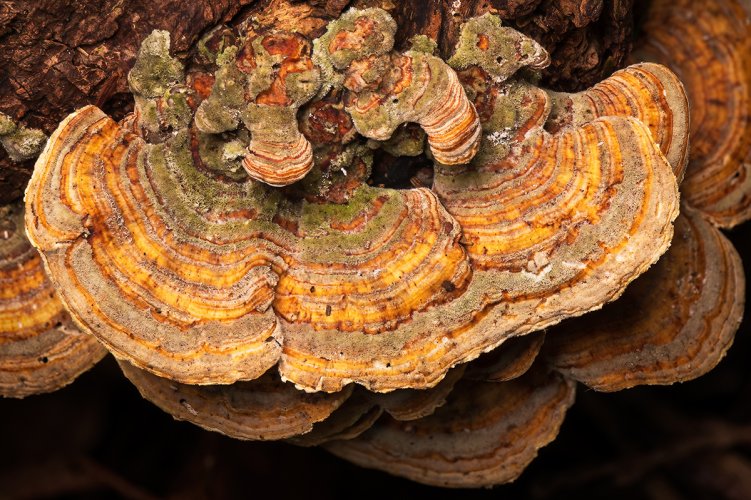- Post score: 16
- #1
Pictures of turkey tail fungus taken in my backyard in Puget Sound during the last week. The fungus (or mushroom), Trametes versicolor(?), is on dead logs or stumps of Douglas firs or hemlocks in the dark parts of my yard (i.e., most of it), which is quite wet during the Pacific Northwest rainy season that started again a couple of weeks ago and will go on until July 4. The turkey tail fungus doesn’t have a stalk, is multicolored, and has small hairs on the upper part so it feels like felt, and has pores on the bottom of the cup.
All of the following images were taken with a D850. The first is a focus stack of a 3.3” specimen. Micro-Nikkor 105 mm f/2.8 G, focus-shift shooting. Eighteen shots at 1/20 sec, f/11, ISO 160, lit by a 9x14-inch LED light panel, stacked in PS, sharpened a bit with Topaz DeNoise AI.

A few inches away from that one was Old Fungus Face (single shot at 1/30, f/16, ISO 200)

Here’s the underside of another specimen, showing the pores. This was a stack in PS of 10 hand-held exposures taken in open shade with a Micro-Nikkor 55 mm f/2.8 AIS lens at 1/160 sec, f/5.6, ISO 280, and yes, it's a manual focus lens. This photo also gave me the opportunity to try the Image>Analysis features in PS to show the approximate scale of the fungus (the ruler was cropped out of the picture).

Finally, to show the pore detail, I used a Nikon PB-6 bellows with a 50 mm f/2.8 Schneider Componon-S enlarging lens at about 1.7x to shoot the inset area in the above image. The lighting was by a 7x9 inch light panel (1/25 sec, f/11, ISO 220). Live view with focus peaking really helps when shooting with a bellows or extension tubes. This shot happened to catch a critter (about 1.5 mm long) that’s probably responsible for the burrows and holes that extend through the fungus cap. Topaz Sharpen AI was used to bring up the details of the critter and the pores.

Glen
All of the following images were taken with a D850. The first is a focus stack of a 3.3” specimen. Micro-Nikkor 105 mm f/2.8 G, focus-shift shooting. Eighteen shots at 1/20 sec, f/11, ISO 160, lit by a 9x14-inch LED light panel, stacked in PS, sharpened a bit with Topaz DeNoise AI.
You can only see EXIF info for this image if you are logged in.
A few inches away from that one was Old Fungus Face (single shot at 1/30, f/16, ISO 200)
You can only see EXIF info for this image if you are logged in.
Here’s the underside of another specimen, showing the pores. This was a stack in PS of 10 hand-held exposures taken in open shade with a Micro-Nikkor 55 mm f/2.8 AIS lens at 1/160 sec, f/5.6, ISO 280, and yes, it's a manual focus lens. This photo also gave me the opportunity to try the Image>Analysis features in PS to show the approximate scale of the fungus (the ruler was cropped out of the picture).
You can only see EXIF info for this image if you are logged in.
Finally, to show the pore detail, I used a Nikon PB-6 bellows with a 50 mm f/2.8 Schneider Componon-S enlarging lens at about 1.7x to shoot the inset area in the above image. The lighting was by a 7x9 inch light panel (1/25 sec, f/11, ISO 220). Live view with focus peaking really helps when shooting with a bellows or extension tubes. This shot happened to catch a critter (about 1.5 mm long) that’s probably responsible for the burrows and holes that extend through the fungus cap. Topaz Sharpen AI was used to bring up the details of the critter and the pores.
You can only see EXIF info for this image if you are logged in.
Glen


